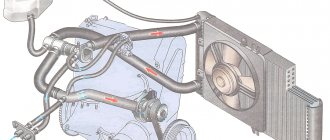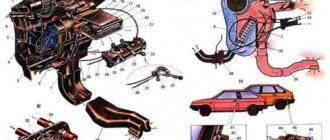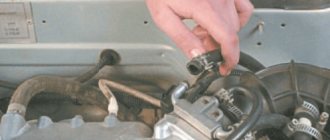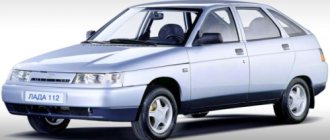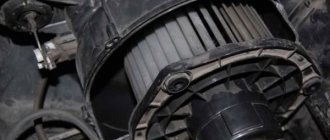If the antifreeze is not changed correctly, a plug of air appears in the cooling system pipes of the VAZ 2110, which can significantly damage the engine, leading to its overheating, and also block the functionality of the heating system. Engine functionality in unexpected temperature mode, almost any engine system or component wears out badly or requires complete repair. For those who have encountered a similar difficulty and are wondering how to remove an air lock from the cooling system of a VAZ 2110 injector, this information is given. I hasten to please you, this problem can be easily solved. And to modify the cooling system of the VAZ 2110, you only need a screwdriver, although sometimes you can do without it.
It should also be noted that most car drivers have encountered this difficulty. Many of them immediately panic. However, if everything is corrected in time, then there is nothing difficult about it.
Removing air from the heating system of the VAZ-2110
Problems with the heating system of domestic cars are far from uncommon. Most often, car owners pay attention to existing faults in winter, when the temperature outside the windows is very different from comfortable. One of the possible reasons for the flow of cold air into the vehicle interior instead of hot air may be the presence of air blockage in the heating system.
In this article, we will look at the reasons for airing in the VAZ-2110 stove, and how to remove air from the heating system of the vehicle.
Reasons for the occurrence of an air lock in the heating system of the VAZ-2110
An air lock most often appears in the pipes and hoses of the engine cooling system. The appearance of a blockage will negatively affect not only the operation of the heater, but also the functionality of the vehicle engine. Air-filled hoses lose their capacity, which causes overheating of the power unit and boiling of the coolant in the heating system. If you do not remove the air lock, the consequences can be varied - from damage to the heater radiator to overheating of the car's power unit.
The causes of blockage can be different. Sometimes it is not enough to simply force the air out of the system, but it is necessary to eliminate the original source of the problem. One of the most popular reasons is improper replacement of coolant. In such a situation, it is enough to simply remove the air lock and then follow the manufacturer’s instructions when adding or replacing antifreeze. To perform the work correctly, it is important to unscrew the necessary hoses and pipes.
Air leaks are often caused by depressurization or damage to parts of the engine cooling and interior heating systems. The cause of depressurization is poorly tightened clamps on hoses and pipes. As a result, air enters through small holes and air pockets form. In this case, you first need to check the reliability of the hose fastenings, and only after that you need to remove the plug. The presence of damaged parts in the cooling system can be identified by traces of leaking antifreeze in the engine compartment. If there are such traces, then it is necessary to find and replace the element that has become unusable, otherwise after removing the plug it will appear again.
Typical faults
If the cooling system of the “tens” begins to work not as it should, this indicates a malfunction.
You can identify them based on their characteristics.
Methods for venting the VAZ-2110 stove
Sometimes, after adding or completely replacing antifreeze, the stove on a VAZ-2110 stops heating. If the heater core is hot, then there is a high probability that air has entered the heater. If the VAZ-2110 stove is airy, it is necessary to remove the air from the heater for its normal functioning.
There are several effective, simple ways to fix the problem that even a novice driver can handle.
The first option involves removing the air plug using simple manipulations in the engine compartment of the car. First you need to unscrew the cap of the expansion tank. In the engine compartment near the radiator of the car, you need to find hoses for supplying and discharging coolant. The air must be expelled by sharply pressing both hoses for a short time. After this, tighten the tank cap and check whether the air lock has been removed. To do this, you need to start the car and turn on the heater at maximum speed. If the problem is not resolved, you need to look for the cause elsewhere, or try the following method.
To eliminate air from the stove using the second method, you need to find an overpass or a high hill, and place the car so that its front part is as high as possible. After this, you need to start the car and let it idle for several minutes. If such actions do not produce results, you can repeat the procedure by adding accelerator pressure with the gas pedal.
After removing the plug, you need to add antifreeze to the expansion tank to the normal level and close the tank lid tightly. You should not add liquid very suddenly, as this may cause the air to reappear.
The third method of eliminating the problem when the VAZ-2110 stove is airing is the most effective and efficient. However, this method is slightly more difficult to implement. To make the work more convenient, you may need the help of a friend.
First you need to find and disconnect the antifreeze drain hose. This must be done very carefully, as antifreeze may leak from it or from the fitting. If liquid leaks, you need to pinch the hole with your finger. If there is an air lock, then antifreeze will not flow from the hose.
After this, you need to slowly add antifreeze prepared in advance. It is necessary to fill until it flows from the hose or its level reaches the maximum value in the expansion tank.
Cleaning or replacing the radiator
The radiator, located in the front of the car, absorbs the main flow of dust and dirt. For its effective operation, timely maintenance and cleaning is required. The radiator can become dirty both inside and outside.
An indicator of internal cleanliness is the condition of the coolant. Manufacturers recommend replacing antifreeze every 75,000 km or every 5 years. However, changes in the color of the liquid, severe darkening, discoloration, and the presence of rust require urgent replacement of the coolant. It is recommended to replace antifreeze at least every 40,000 km.
To carry out internal cleaning of the cooling system of VAZ 2110, 2114, 2115, it is necessary to drain the liquid. Sequencing:
- open the expansion tank cap;
- replace the antifreeze drain container;
- unscrew the drain plug from the cylinder block;
- drain the coolant;
- unscrew the radiator drain plug (located at the lowest point);
- drain the remaining antifreeze (antifreeze);
- tighten all caps.
To clean, distilled water is poured into the system and the engine is started for about 20 minutes. Ordinary water contains many impurities and forms scale, so its use is undesirable. The liquid is drained several times until clean water flows. This method is ineffective as it removes only a small amount of deposits.
For more effective washing, it is recommended to use special chemical additives. The detergent components they contain allow you to dissolve deposits and remove various types of contaminants. The vinegar and water mixture that many motorists use is less effective. It does not remove all deposits. After applying the chemicals, the cooling system is flushed with distillate.
After cleaning the entire cleaning system of the VAZ 2110, 2114, 2115, an additional internal flushing of the radiator is carried out. To do this, you need to disconnect the pipes from the base and the upper and upper container. The fluid is poured into the radiator through the upper hose using a garden hose. Flushing is carried out until clean water flows from the lower pipe.
The removed radiator can be cleaned from the outside to remove dirt, insects, and sand from the cooler honeycomb. For cleaning, use soapy water or special devices that create a strong flow of water or air, for example, a Karcher vacuum cleaner. The procedure must be carried out carefully so as not to bend the radiator honeycombs.
If damaged or heavily soiled, the radiator must be replaced.
Replacing the thermostat
If the thermostat valve is not working properly, coolant is not circulating in the large SOD circle. At the same time, the lower pipe remains cold even after the refrigerant reaches 90°C. The upper pipe may be hot due to the steam escaping. The thermostat can also be stuck open, in which case the engine does not warm up to the desired temperature or takes too long to overheat.
In preparation for replacing the unit, you must empty the system and remove the air filter. Then disconnect the radiator and fluid pump hoses from the thermostat housing. Then loosen the mounting bolts and remove the thermostat cover. The device is replaced with a working one. The thermostat is connected in reverse order.
These are the main reasons for the malfunction of the cooling system and the cold lower pipe of VAZ 2110, 2114, 2115 cars.
Let's sum it up
Air entering the vehicle heater can negatively affect not only the functionality of the heater and comfort in the cabin, but also affect the operation of more significant units and parts in the car. Timely detection and elimination of the problem will help you save on the purchase of expensive heater components and repairs to the car’s power unit.
Be very attentive to even seemingly frivolous problems in the operation of your vehicle. Simple preventive measures to care for the interior heating elements will have a positive impact on the functionality of the vehicle as a whole.
Source
Correctly expelling air from the cooling system on the VAZ-2110
The appearance of air locks in the cooling system of the VAZ-2110 is not a critical problem and can be easily eliminated. However, air in the system can cause great harm to the engine, causing overheating and can block the operation of the heater core. And engine operation at abnormal temperatures leads to severe wear and failure of almost any engine system or component. We will consider the signs, reasons for the appearance and methods of removing air plugs from the cooling system of the VAZ-2110 today.
Causes of poor coolant circulation
According to the diagram above, the reason that the lower radiator hose in the VAZ 2110, 2114, 2115 remains cold is the lack of fluid circulation throughout a large circle of the system. Note that the radiator is the main cooling element. Thus, the upper pipe through which the liquid enters the heat exchanger will be warmer than the lower one even if the liquid circulates correctly.
Possible causes of stagnation in the cooling system:
- the radiator is clogged;
- The thermostat does not work;
- Gateway;
- pump failure.
Any work on the engine cooling system requires subsequent flushing of the ODS and replacement of the coolant. Poor quality coolant cannot cope with engine cooling and can lead to system blockage.
Signs of an air lock in the cooling system
Air pockets in the cooling system can cause the engine to overheat.
The first and most important symptom of traffic jams is engine overheating, poor heater performance and fluid leakage.
The cooling system of any engine must maintain tightness . In the old classic carburetor VAZ models, as in other cars of that period, antifreeze was added to the system both through the expansion tank and through the radiator cap. However, with the transition to new technologies, it was possible to improve the tightness of the system and improve its operation.
Therefore, there was no need for a radiator cap. This was largely possible thanks to the use of more advanced antifreezes, which boil and release air at higher temperatures.
Reasons for appearance
The first and main reason for the disruption of coolant circulation through the system is its leakage.
Cooling system of the VAZ-2110 injection engine.
- Flowing through the cracks, the volume will certainly be filled with air, which enters through the expansion tank plug . Next, air bubbles disperse throughout the system and clog it in the most vulnerable places.
- Another reason for the appearance of traffic jams is the boiling of low-quality liquids . When using antifreezes such as Tosol or similar suspicious compounds (basically water stained with blue), the boiling threshold shifts as close as possible to the operating temperature of the engine .
As you know, water boils at approximately 100°C and this leads to the active release of steam. And the fan on the VAZ-2110 only turns on at a liquid temperature of about 100°C. Hence the appearance of air in the system and “overheating without overheating.” Any good antifreeze calmly holds temperatures up to 130-150 ° C without releasing steam (pure ethylene glycol boils at a temperature of under 200 degrees). It is for this reason that plugs so often appear in the cooling system among those who like to save on antifreeze.
In short, yes. Now we will remove the consequences of saving or breaking the tightness of the system.
Prevention measures
Most breakdowns can be avoided by handling your vehicle correctly. Yes, no one excludes unforeseen situations, but simple preventive measures should certainly become the norm for driving a car:
- Constantly check the coolant level indicator in the tank and top up if necessary;
- For your VAZ 2110, do not skimp on high-quality coolant;
- Do not use ordinary water as a coolant, as it has a lower boiling point and promotes scale formation and corrosion inside the cooling system;
- Always look at the readings of the coolant temperature sensor located inside the car. Avoid situations where the arrow crosses the red line.
Obviously, CO is the most important unit in the engine compartment, the effectiveness of which depends on the condition, performance of the engine and other things. Therefore, it is extremely important to take care of the cooling system, monitor its condition and promptly eliminate any malfunctions that arise.
A cold lower radiator hose after the VAZ 2110, 2114, 2115 engine has warmed up indicates a problem in the vehicle’s cooling system. If normal operation is not restored, the engine will overheat and fail. There may be several reasons for the malfunction of the cooling system of a VAZ 2114, 2115, 2110 car. And even experienced motorists cannot always understand why the lower radiator hose of a car remains cold.
Three ways to remove an air lock on a VAZ-2110
Removing a traffic jam is as easy as earning it. There are at least three methods, each of which requires different efforts and varies in effectiveness.
For real men
This is a proven and effective method, and it consists in the fact that we artificially depressurize the cooling system at its highest point on the engine and, thus, expel all the air completely.
- This point is the antifreeze supply pipe to the throttle assembly (on injection units). To do this, we need to warm up the engine to operating temperature so that the thermostat valve opens.
- We work on a flat surface wearing protective gloves, since the temperature of the liquid is at least 90 degrees .
- Loosen the pipe clamp and remove it from the fitting.
Symptoms of airiness
How can you tell if there is an air lock in the cooling system? When this phenomenon occurs, several typical symptoms occur. Among them:
- Problems with the thermostat . More specifically, if after starting the engine the cooling fan turns on very quickly, then there is a high probability that the thermostat has failed. Another reason for this may be that air has accumulated in the pump nozzle. If the thermostat valve is closed, the antifreeze circulates in a small circle. Another situation is possible when the coolant temperature needle is at “zero” when the engine has already warmed up enough. Here again, two options are possible - a malfunction of the thermostat, or the presence of an air lock in it.
- Antifreeze leak . It can be checked visually by traces of antifreeze on individual elements of the engine or chassis of the car.
- The pump starts to make noise . When it partially fails, extraneous noise appears.
- Problems with the stove . There are many reasons for this malfunction, but one of them is the formation of an air lock in the cooling system.
If you find at least one of the symptoms described above, then you need to diagnose the cooling system. However, before doing this, it will be useful to understand what caused the possible problems.
conclusions
After using each method, it is necessary to check the functionality of the heater and the temperature of the engine - the engine should not overheat.
Of course, the most effective method is a complete replacement of antifreeze and it is suitable in cases where the liquid has completely exhausted its service life and requires urgent replacement. Moreover, it is better to do this as soon as possible so as not to cause the appearance of new air jams. Good luck to everyone and clean antifreeze in the engine!
Source
How to remove an air lock on a VAZ 2110, VAZ 2111, VAZ 2112?
Welcome! Air lock - it forms in the pipes of the cooling system, and it occurs most often after incorrectly replacing the coolant (The word incorrect means that you replaced the fluid without disconnecting some hoses, as you should do when replacing the fluid), but this plug is not so and it’s hard to remove, you just need to know just a few tips that we will give you, so read the article further and, so to speak, delve into all the details of removing the air lock from the system.
Note! In order to remove the plug from the cooling system, you will need to stock up on: Just one single screwdriver, or it may not even be useful, but still take it just in case!
When should you remove an air lock from the cooling system? Usually, after an air lock appears in the system, something wrong begins to happen with the car’s engine, namely with the cooling system, namely, the car begins to heat up very quickly to high temperatures, and the stove can heat worse due to the air jam (This is especially noticeable in winter).
Note! The car can overheat not only because of the plug, but also a faulty thermostat can lead to this, so if after you remove the plug and nothing happens, then check the thermostat for functionality, read the article on how to do this entitled: “Replacing the thermostat on a VAZ”!
And one more thing, as you already understood earlier, an air plug appears mainly only when the fluid is replaced with a new one, but this is not always the case, in general we will add: This plug appears in the system in some cases, namely after a thorough overheating of the engine for heat, as well as after depressurization of the system (Basically, depressurization occurs from poorly tightened clamps that secure the hoses of the system, and through these cracks in the hoses where the clamp is poorly tightened and air passes through, thereby leading the system to an air lock)!
And also, a plug may appear during the same depressurization of the system, but this time if there is damage to any part of the system, that is, if you see traces of coolant on the car engine, then this already indicates that some hose does not fit tightly to the the body on which it is placed, or somewhere that is faulty (Deformed), so look for what the problem is and after finding the problem, fix it, and if a plug appears, then in that case, drive it out of the system!
How to prevent the problem from recurring
The surest way to avoid unnecessary problems with your car is to trust the service to professionals. The structure of a car and an engine in particular is constantly becoming more complex. A modern cooling system consists of many irregularly shaped parts, tubes and hoses located at different angles. In a word, there are many places where air can accumulate in the cooling system. Professionals know all the intricacies of filling the antifreeze system and can easily replace the old fluid with a new one.
There is no need to allow the engine to overheat, bring the antifreeze to a boil. At this moment, the coolant turns into steam, which, under high pressure (the system is closed) fills all the most inaccessible corners of the cooling system. In this case, the engine itself is at great risk of serious damage. It also takes a lot of skill and experience to remove air from your car's cooling system.
If you do not remove the air lock from the cooling system in time, there is a chance that the engine will incur significant costs for repair and restoration. So the question “how to remove air from the cooling system” must be taken seriously.
Source


